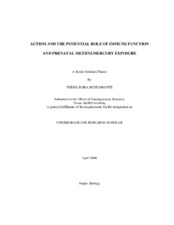| dc.description.abstract | Methylmercury (MeHg) remains to be a major public health concern because of the presence of widespread contamination of our environment and the severe neuropathological changes that can occur with exposure to the developing central nervous system (CNS). The blood-brain barrier (BBB) represents an important target for MeHg. However, before the BBB is fully formed or if the BBB is compromised once it is formed, it can not effectively isolate the brain from circulating toxins and foreign compounds. The current project examines the hypothesis that there is a correlation between childhood vaccination and the neurotoxic effects of mercury in the form of MeHg in the pathogenesis of autism. The effects from exposure to MeHg and activation of the immune system can affect neuronal survival and development and could result in the faulty wiring that appears to occur in the CNS of autistic children. Mice were exposed to low dose (0.03 µg/kg of body weight of the pregnant mouse) MeHg during prenatal development. Lipopolysaccharide (LPS) was administered during early
iv
postnatal development as an immunostimulant. In order to determine the optimal time in which the injection of LPS would be the most effective, mice were injected with LPS then euthanized and injected with Evans Blue dye at 4, 6, 22, and 48 hours. The brain was separated into forebrain, cerebellum, and brainstem. Using a fluorescence micro plate reader, the quantity of Evans Blue leaking into the brain through the BBB was calculated. It was determined the mice should be euthanized 6 hours after administration of LPS. LPS or the control solution, phosphate buffered saline (PBS), was administered at postnatal day 18 into mouse pups that received MeHg prenatally and then the integrity of the BBB was checked 6 hours later. No difference was observed between mice given LPS compared to the mice given PBS most likely due to too much variability. There may be an effect of LPS but it is masked by the variability that occurs when using this assay in such young mice. A radioactive assay using 14C-labeled sucrose is going to be used in order to acquire better results. | en |


